 |
Far too much ink has been spilled over the link between Ludwig van Beethoven’s Third Symphony and Napoleon Bonaparte.  (Lest one doubt the strength and persistence of that connection, just consider the album covers throughout this article.) The bond stems from one of the most well-known anecdotes in music history. (Lest one doubt the strength and persistence of that connection, just consider the album covers throughout this article.) The bond stems from one of the most well-known anecdotes in music history.
 Ferdinand Ries, Beethoven’s student and friend, recalled seeing the Italianate title page of a new symphony in the Spring of 1804, entitled, simply, “Buonaparte” on top and “Luigi von Beethoven” at the bottom. Ferdinand Ries, Beethoven’s student and friend, recalled seeing the Italianate title page of a new symphony in the Spring of 1804, entitled, simply, “Buonaparte” on top and “Luigi von Beethoven” at the bottom. 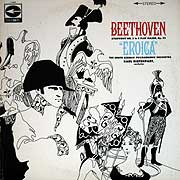 His dramatic account continues on the day [May 18, 1804] when Ries brought news that Napoleon had declared himself emperor: “Thereupon [Beethoven] flew into a rage and cried out: ‘He will trample all the Rights of Man and only indulge his ambition … and become a tyrant.’ Beethoven went to the table, seized the title page from the top, tore it up completely and threw it on the floor. The first page was written out anew and … received the title Sinfonia eroica [Heroic Symphony].” His dramatic account continues on the day [May 18, 1804] when Ries brought news that Napoleon had declared himself emperor: “Thereupon [Beethoven] flew into a rage and cried out: ‘He will trample all the Rights of Man and only indulge his ambition … and become a tyrant.’ Beethoven went to the table, seized the title page from the top, tore it up completely and threw it on the floor. The first page was written out anew and … received the title Sinfonia eroica [Heroic Symphony].”
While the original manuscript no longer exists,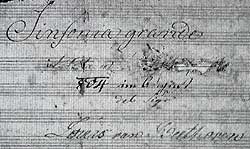 indirect substantiation of this seemingly apocryphal incident survives in a copy of the score in the Library of the Gesellschaft der Musikfreunde in Vienna bearing Beethoven’s handwritten notes and remarks. The cover page reads, line by line: “Sinfonia Grande / Intitulata Bonaparte / 804 im August / del Sigr. / Louis van Beethoven” – but the second line has been partially erased so forcefully as to have torn right through the page. Yet, Beethoven did not entirely disavow his former hero – he added to the bottom of the page in pencil: “Geschrieben / auf Bonaparte” (“Written [literally: ‘on’; more figuratively: ‘for’ or ‘about’] Bonaparte”). Indeed, when the news arrived in 1817 that Napoleon had died, Beethoven remarked that he had already composed the proper music and referred to his Third Symphony. Yet, as Edward Tintall Canby notes, Napoleon’s lust for personal power surfaced early on, and so he was never quite the democrat that Beethoven supposed, but rather a heroic abstraction. Although Beethoven may have lost the living symbol, his ideal remained intact. Thus, when the score was first published in 1806, it bore the designation: “per festeggiare il souvenire di on grand Uomo” (“to celebrate the memory of a great Man”). indirect substantiation of this seemingly apocryphal incident survives in a copy of the score in the Library of the Gesellschaft der Musikfreunde in Vienna bearing Beethoven’s handwritten notes and remarks. The cover page reads, line by line: “Sinfonia Grande / Intitulata Bonaparte / 804 im August / del Sigr. / Louis van Beethoven” – but the second line has been partially erased so forcefully as to have torn right through the page. Yet, Beethoven did not entirely disavow his former hero – he added to the bottom of the page in pencil: “Geschrieben / auf Bonaparte” (“Written [literally: ‘on’; more figuratively: ‘for’ or ‘about’] Bonaparte”). Indeed, when the news arrived in 1817 that Napoleon had died, Beethoven remarked that he had already composed the proper music and referred to his Third Symphony. Yet, as Edward Tintall Canby notes, Napoleon’s lust for personal power surfaced early on, and so he was never quite the democrat that Beethoven supposed, but rather a heroic abstraction. Although Beethoven may have lost the living symbol, his ideal remained intact. Thus, when the score was first published in 1806, it bore the designation: “per festeggiare il souvenire di on grand Uomo” (“to celebrate the memory of a great Man”).
In any event, Beethoven deeply admired Napoleon during the time when he wrote his Symphony # 3. George Grove attributes Beethoven’s deep esteem for Napoleon to his status as the restorer of order and prosperity, a passionate champion of freedom, and the symbol of the hope of the French Revolution (as well as the embodiment and validation of Beethoven’s own personal sense of arrogance, invention and iconoclasm). Many writers have gone on to assume rather foolishly that Beethoven took his inspiration literally.  Thus, Dr. Charles Wood assures us: “We know that Beethoven, when composing, had a picture in his mind.” The only problem with this approach is that different analysts find vastly different pictures from the same score. Thus Dr. Wood declared that the third movement depicted: “A crowd, full of pent-up excitement … awaiting the ‘hero.’ His approach is welcomed by a sudden shout. … His object in coming is … an address to the people. … His speech is received with marks of approval and cheers.” Yet a 1845 New York Philharmonic Society program note asserted that the same movement described the homeward march of soldiery. Hector Berlioz claimed that it portrayed the happy rites of Greek warriors at the tomb of their leader. One can just as easily hear the rippling of water, schools of fish and shifting cloud formations reflected in the stream that passed by the house where Beethoven wrote the symphony. Thus, Dr. Charles Wood assures us: “We know that Beethoven, when composing, had a picture in his mind.” The only problem with this approach is that different analysts find vastly different pictures from the same score. Thus Dr. Wood declared that the third movement depicted: “A crowd, full of pent-up excitement … awaiting the ‘hero.’ His approach is welcomed by a sudden shout. … His object in coming is … an address to the people. … His speech is received with marks of approval and cheers.” Yet a 1845 New York Philharmonic Society program note asserted that the same movement described the homeward march of soldiery. Hector Berlioz claimed that it portrayed the happy rites of Greek warriors at the tomb of their leader. One can just as easily hear the rippling of water, schools of fish and shifting cloud formations reflected in the stream that passed by the house where Beethoven wrote the symphony.
Others have gone further to dismiss the very notion of translating Beethoven’s vision into a sequence of specific events. Robert Haven Schauffler calls literalism the natural foe of music: “Does it really matter what concrete image the Master’s conscious mind played with as long as his unconscious gave us something that so far transcends any poetic image? … His music is too universal for the narrow scope of any one event.” 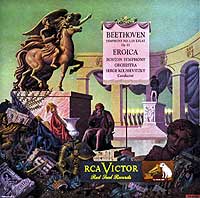 Donald Tovey claimed that “Beethoven was not interested in specific people but as types of strength of man’s will, death in majesty and of creative power” and that the symphony expressed general feelings concerning heroes and hero-worship. Richard Wagner agreed, contending that it explored the four phases of heroism – action, tragedy, serenity and love. Irving Kolodin dismissed extrinsic reference points altogether, viewing the Eroica as a portrait not of Napoleon but of Beethoven himself. Canby places the work in the broader context of the artistic development of its era: “The truth is that the Eroica celebrates most of all its own time personified in a heroic abstraction. Those feelings which were truly new and great, in this exhilarating era of the birth of freedom, are contained inimitably and for the first time in music within its classic expression.” Donald Tovey claimed that “Beethoven was not interested in specific people but as types of strength of man’s will, death in majesty and of creative power” and that the symphony expressed general feelings concerning heroes and hero-worship. Richard Wagner agreed, contending that it explored the four phases of heroism – action, tragedy, serenity and love. Irving Kolodin dismissed extrinsic reference points altogether, viewing the Eroica as a portrait not of Napoleon but of Beethoven himself. Canby places the work in the broader context of the artistic development of its era: “The truth is that the Eroica celebrates most of all its own time personified in a heroic abstraction. Those feelings which were truly new and great, in this exhilarating era of the birth of freedom, are contained inimitably and for the first time in music within its classic expression.”
Other theorists go even further to reject all attempts to relate the work to any anchor of human experience at all and maintain that great art speaks a language all its own. Frank Howes contends that the work’s logic is not historical or biographical but symphonic. Klaus George Roy decries the danger of picking a work apart for detailed parallels to human situations, as it obscures the integrity and autonomy of musical speech and diverts us from the experience of artistic understanding. Yet, it is an innate human tendency to seek meaning in even the most abstract art. Scott Burnham acknowledges our compulsion to use anthropomorphic metaphor to personalize and understand musical abstraction and salutes Beethoven for having expressed human values in a universality that embraces all individualities to enable each of us to be engaged at a personal level. On a more practical level, William Mann excuses the narratives’ contradictions by pointing out that because music is a non-specific language with its own logic its message is for each to understand in his own way. In that light, the disparate interpretations of the Eroica just might serve as a tribute to the extraordinary power of the work, which speaks compellingly, yet personally and differently, to anyone willing to engage it. But perhaps the most sensible approach after all lies in Arturo Toscanini’s famous quip: “To some it is Napoleon, to some it is philosophical struggle; to me it is Allegro con brio.”
 After a private performance at the palace of its dedicatee, Prince Lobkowitz, in December 1804 and once more at the home of a Herr von Würth, a wealthy banker, in January 1805, Beethoven conducted the public premiere in Vienna on April 7, 1805. After a private performance at the palace of its dedicatee, Prince Lobkowitz, in December 1804 and once more at the home of a Herr von Würth, a wealthy banker, in January 1805, Beethoven conducted the public premiere in Vienna on April 7, 1805.  Critics were baffled and hostile, focusing their concern on two ostensible flaws – difficulty and sheer length. Thus, a February 1805 review in the Allgemeine musikalische Zeitung, while conceding “very daring ideas … very powerfully carried out,” panned the “inordinate length and extreme difficulty of execution.” It continued: “There is no lack of striking and beautiful passages in which the force and talent of the author are obvious; but on the other hand the work seems often to lose itself in utter confusion. … The Symphony would gain immensely if Beethoven would decide to shorten it and introduce into the whole more light, clarity and unity.” It concluded: “There were very few people who liked the symphony.” A review of the public premiere in Der Fremüthige (“The Outspoken”) agreed: “There are many beautiful things in the symphony but the continuity often appears to be completely confused and the endless duration of this longest and perhaps most difficult of all symphonies is tiring even for the expert; for a mere amateur it is unbearable.” It cautioned that “if Beethoven continues along this road, he and the audience will make a bad journey” in which listeners will “derive absolutely no pleasure” and “would leave the concert hall with only an unpleasant feeling of exhaustion.” Critics were baffled and hostile, focusing their concern on two ostensible flaws – difficulty and sheer length. Thus, a February 1805 review in the Allgemeine musikalische Zeitung, while conceding “very daring ideas … very powerfully carried out,” panned the “inordinate length and extreme difficulty of execution.” It continued: “There is no lack of striking and beautiful passages in which the force and talent of the author are obvious; but on the other hand the work seems often to lose itself in utter confusion. … The Symphony would gain immensely if Beethoven would decide to shorten it and introduce into the whole more light, clarity and unity.” It concluded: “There were very few people who liked the symphony.” A review of the public premiere in Der Fremüthige (“The Outspoken”) agreed: “There are many beautiful things in the symphony but the continuity often appears to be completely confused and the endless duration of this longest and perhaps most difficult of all symphonies is tiring even for the expert; for a mere amateur it is unbearable.” It cautioned that “if Beethoven continues along this road, he and the audience will make a bad journey” in which listeners will “derive absolutely no pleasure” and “would leave the concert hall with only an unpleasant feeling of exhaustion.”
The innovative nature of the work, and the sheer density of its ideas, are evident from the very outset – indeed, from the first eight seconds. Symphonic convention required either a slow introduction or the immediate presentation of the main theme. Beethoven, though, begins with something wholly novel – two sharp full orchestral chords that demand attention while forcefully establishing the E-flat major tonic and marking the rapid tempo.

The opening chords and theme of the first movement |
Interestingly, Beethoven’s sketches show the chords as syncopated dissonances separated by a lingering resonance, but he clearly came to prefer the elegance of the final version. The theme itself is triply novel – it is given by the cellos and basses, rather than the violins in customary scoring; it is in triple, rather than the customary common, time; and it is deceptively simplistic, a mere outline of the tonic chord, seemingly no more complex than the rising figure that began Beethoven’s first piano sonata – until the seventh measure, which wrenches us out of the barely-established comfort of c minor to dwell on a held c-sharp, creating a bitter tritone with the second violins’ repeated g-naturals, thus throwing the harmony into doubt. At the same time, the first violins enter with a syncopated figure to suggest that the rhythm, too, is about to become unstable, as indeed it soon will be.

The similar theme by Mozart |
(As many have noticed, the magnificent theme is virtually identical to that of the 13-year old Mozart’s little known overture to his 1768 operetta Bastien et Bastienne – but there the resemblance stops, as only Beethoven derives a world of ingenuity from such a simple resource.) Mann contends that, by lifting the humblest of themes to supreme nobility, Beethoven suggests that any person, no matter how humble, can transcend his origins to achieve greatness.
The opening is no fluke – the catalog of innovations Beethoven introduced in this work is truly astounding, and their cumulative impact helps to explain the resistance, incomprehension and, indeed, outright shock of early listeners. Indeed, each of the four movements presents a formidable challenge in light of the conventions of the time. Many perceptive analyses and entire books have explored these, but it’s still important to summarize them.
First, though, I must digress to deflate an all too widespread claim among commentators that the Eroica was of unprecedented length. As we have noted, this alleged distinction began with the earliest critics. Yet, if all repeats are taken (as they undoubtedly were at the time) and when played at conventional tempos, Mozart’s final two symphonies last nearly 40 minutes; the Eroica, taken at the rapid clip specified by Beethoven, including all his repeats, is nearly the same. So sheer length was not the issue. 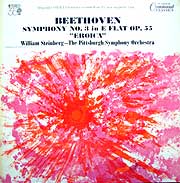 Rather, it is the density of his ideas, the challenging way he develops them, and, above all, the demanding emotional content of the work that give a perception of length that well exceeds the temporal reality. Beethoven surely was aware of the magnitude and difficulty of his new work. He prefaced the first edition of the score with a prescient note: “This symphony, being purposely written at greater length than usual, should be played nearer the beginning than the end of a concert … lest, if it is heard too late when the audience are fatigued by the previous pieces, it should lose its proper and intended effect.” Rather, it is the density of his ideas, the challenging way he develops them, and, above all, the demanding emotional content of the work that give a perception of length that well exceeds the temporal reality. Beethoven surely was aware of the magnitude and difficulty of his new work. He prefaced the first edition of the score with a prescient note: “This symphony, being purposely written at greater length than usual, should be played nearer the beginning than the end of a concert … lest, if it is heard too late when the audience are fatigued by the previous pieces, it should lose its proper and intended effect.”
We have already noted the extraordinary opening of the first movement, which presents Beethoven’s grand plan in microcosm – but only after those bold opening chords that clearly announce that this is going to renounce an amusing evening of trifling pleasure to delve far deeper into the potential of art. He deepens the gravity with the first appearance of three horns in an orchestral work (with the consequent thickening of the texture and expansion of the middle harmonies they permit). Indeed, it has been remarked that this symphony marks a maturity of orchestration beyond mere functionality to an element of powerful expression. Beethoven expands the development section of sonata form from a relatively brief transition leading from exposition to recapitulation into a segment of equal, if not greater, stature, with numerous episodes that thoroughly explore the themes in new lights. Thus, the length of the first movement development – 244 measures – vastly exceeds that of its exposition and recapitulation – 152 measures each. Similarly, he elevates the coda from a closing fillip to a powerful summation with its own developmental exploration of the movement’s materials – its 139 measures nearly match the length of the recapitulation. (As a comparison, in the first movement of Beethoven’s affable Symphony # 1, the exposition and recapitulation are 96 measures, the development 67 and the coda 28.) The second of his two primary themes is constantly deferred and when it finally arrives is organically connected to and tends to evolve from the first theme, rather than merely contrast with it. Schauffler notes that in place of somewhat arbitrary and conventional passagework, Beethoven advances his themes and their variants with ordered and convincing progress, thus fusing the sonata form into an organic unity, which he compares to the difference between an anthology of short stories and an epic novel. Beethoven’s harmonic excursions vastly exceed the norm and, although in triple time, he radically confounds the rhythm by accentuating the first and third, and then the second, beats of alternate measures (1-2-3, 1-2-3 ...) to imply a shift to duple time.
Those who seek a biographical narrative in the Eroica meet their stiffest challenge in having to explain the second movement – a funeral march (written, of course, while Napoleon was not only very much alive and triumphant, but firmly ensconced in Beethoven’s affections).

The theme of the funeral march |
If at any point in the entire work descriptive words fail, it is here – the sheer intensity of underlying grief is unprecedented and has never been equaled. The fundamental theme, in c-minor, is both halting and inexorable, then brightens for a contemplative and hopeful C major section, toughens into a resolute fugue, and finally sputters into hesitant fragments, as despair dissolves into desolation. Dr. Wood notes that its theme is an elaboration of the opening played backwards, which he rationalizes as symbolizing death’s reversal of the forward drive of life. (The second theme of the ensuing scherzo and the main theme of the finale are derived from this same germ as well, thus providing the entire work with a remarkable, if subconscious, unity. Schauffer observes that the notes of the motif comprise a bugle call, and so the entire work, being based on this progression, can be viewed as a giant set of variations with an apt militaristic slant.)
Interestingly, Beethoven had created a “Marcia funebre sulla morte d’un eroe” (“Funeral march on the death of a hero”)

The funeral march of the Sonata, Op. 26 |
as the third movement of his 1801 piano sonata in A-Flat Major, Op. 26. Although it sustains a single mood of sorrow and deliberation throughout its entire seven minutes, its stammering theme anticipates the rhythm and even the overall feel of the Eroica movement, intensified by the extremely remote key of a-flat minor (7 flats) that at one point descends even further into c-flat minor (7 flats plus 3 double-flats). While Wagner and others went on to create powerful funeral music, Beethoven’s movement is overwhelmingly effective for its direct sincerity. Maynard Solomon expounds the sheer humanity of Beethoven’s conception. He notes that while prior works in the classical era had undercurrents of sadness, they always respected the Viennese pleasure principle by resolving in reaffirmations of social norms.  But Solomon contends that here, for the first time, tragic expression was placed at the core of a work, with disintegrating forces and intrusions of hostile energy raising the real possibility of lasting loss, while at the same time making the prospect of reaffirmation and renewal emerge all the more powerfully from the depth of true tragedy, an assertion of Schiller’s resistance of morality to suffering (which Beethoven would explore more fully in his only opera, Fidelio). But Solomon contends that here, for the first time, tragic expression was placed at the core of a work, with disintegrating forces and intrusions of hostile energy raising the real possibility of lasting loss, while at the same time making the prospect of reaffirmation and renewal emerge all the more powerfully from the depth of true tragedy, an assertion of Schiller’s resistance of morality to suffering (which Beethoven would explore more fully in his only opera, Fidelio).
Was Beethoven really so inspired by thoughts of a military hero? B. F. Martin suggests that the impetus may have been more personal – Beethoven had just emerged from the depths of his own depression and the brink of suicide over his advancing incurable deafness, and resolved to find a catharsis through music. Indeed, in 1802 he had written: “I am not satisfied with my work up to the present time. From today, I mean to take a new road.” Martin further notes that the entire work made impossible demands on orchestras of the time, which generally consisted of a core group of 20 or so instrumentalists, augmented as needed for specific performances, and suggests that from this point forward Beethoven, freed by his deafness from the tethers and constraints of actual sound, began writing for an idealized orchestra of the future whose sound he could craft only in his imagination. Interestingly, the Der Fremüthige review concluded with an inference that the composer already had parted ways with popular taste – while the audience thought Beethoven rude for not deigning to “even give a nod to the applauding part of the audience” (thus implying that another part had snubbed him altogether), “Beethoven, on the other hand, did not find the applause sufficiently enthusiastic.”
But Beethoven’s innovations did not stop with the funeral march. While the ensuing scherzo served the traditional purpose,

The theme of the scherzo

The three horns' trio of the scherzo |
magnified here, of emerging from sadness through a brisk dance, it presents far more than its predecessors. The theme is playful enough, but its restless motion, uncomfortably brisk tempo and emergence from a quivering base implies an undercurrent of apprehension. For the central trio section, Beethoven exploits his three horns, which blare forth with a solo chorale to display their prowess and declare the value of their first appearance in a symphony. Grove hails the scherzo as the very first time the traditional diversion was invested with a proportion and breadth to compare with the other movements of a symphony.
While the finale is generally described as a theme and variations, Lewis Lockwood analyses it as a wholly new entity, a blending of hybrid forms. Thus, it begins with an onslaught of cascading notes and then patiently states and begins to develop a bass figure that quickens and rises through the higher registers, and finally cedes to the graceful main theme. After five variations that include two fugues and a march, Beethoven breaks the basic tempo for the very first time in the work for an extended andante built on increasing fragmentation of the theme.

The theme and bass figure of the finale |
Then a brief, startling coda suddenly recalls the vigor of the opening and tosses about more thematic fragments while constantly pounding home tonic E-flat major chords. While the closing chords may seem redundant, Edward Tatnall insists that they really are necessary to buttress the end of such a massive, rebellious and complex work.
The theme of the finale clearly had special meaning for Beethoven, as he had already featured it in three recent works. Indeed, he seemed possessed by it. Its first appearance was as a recurring episode in the finale of his 1801 Prometheus ballet, whose heroic subject perhaps suggested its aptness for the Eroica symphony. Indeed, Barry Cooper asserts that the original Eroica audiences would have understood at once that this was an intended reference. The next year, the same theme formed the seventh of twelve brief country dances and (this time with the associated bass figure) the basis for a set of Variations in E-flat for piano (Op. 35). In a sense the piano variations seem a study for Eroica finale, as the introductions and initial developments of the theme and bass are virtually identical, and a lingering largo section foretells the corresponding andante portion of the Eroica. Yet, despite its far greater length (an unprecedented 25 minutes, well over twice the norm of the time), the 15 variations and finale of the piano set, while extremely inventive, are grounded in traditional styles and mannerisms, and lack the epic scope of the Eroica finale. With his symphonic version perhaps Beethoven at last was satisfied that he had wrung all he could from his pet theme, as he never used it again.
Many commentators have viewed the finale in symbolic terms. Irving Kolodin notes that since the new emerges from the old, the venerable variation form represents the act of creation itself.  George Marek asserts that Beethoven transforms the theme into a turbulent life story, ranging from the ominous to pure untroubled beauty. As for its significance to music history, Lockwood declares that it liberated the symphonic finale from the constraints of traditional structure (which generally required a rondo format), so that henceforth any degree of innovation was possible. Indeed, that emancipation applied not only to the form of a finale, but to its wide-ranging emotional content as well – without the path blazed by the Eroica it seems hard to envision such varied symphonic finales as the Brahms Fourth (a passacaglia), the Tchaikovsky Sixth (a paean of abject despair), and all of Bruckner and Mahler – or Beethoven’s own Ninth, for that matter. George Marek asserts that Beethoven transforms the theme into a turbulent life story, ranging from the ominous to pure untroubled beauty. As for its significance to music history, Lockwood declares that it liberated the symphonic finale from the constraints of traditional structure (which generally required a rondo format), so that henceforth any degree of innovation was possible. Indeed, that emancipation applied not only to the form of a finale, but to its wide-ranging emotional content as well – without the path blazed by the Eroica it seems hard to envision such varied symphonic finales as the Brahms Fourth (a passacaglia), the Tchaikovsky Sixth (a paean of abject despair), and all of Bruckner and Mahler – or Beethoven’s own Ninth, for that matter.
Despite the misgivings of the first audiences and critics, the Eroica has since been recognized as the foremost turning point in music history, and perhaps the greatest and most influential work ever written. As expressed by Paul Henry Lang in an oft-quoted passage from his Music in Western Civilization, the Eroica is “one of the incomprehensible deeds in arts and letters, the single greatest step made by an individual composer in the history of the symphony and in the history of music in general. The Eroica simply dwarfs everything in its boldness of conception, breadth of execution and intensity of the logic of construction. Beethoven himself never again approached the feat of fiery imagination: he wrote other, perhaps greater, works but he never again took such a fling at the universe.” William Flanagan states the case more succinctly: “The appearance of no single work has so completely and irretrievably altered the face of art.” To that I would only add that by infusing the Eroica with a panoply of heart-felt, intense emotion, Beethoven blazed a path that led to the music that affects us to this day, from Wagner and Mahler to gospel and heavy metal.
 Performances and recordings of the Eroica present several challenges. The most basic is the overall tempo. One would think that the problem is illusory, as Beethoven himself labeled each movement with not only an admittedly somewhat abstract traditional tempo description (I = allegro con brio; II = adagio assai; III = allegro vivace; IV = allegro molto), but with a clear and specific metronome markings. Performances and recordings of the Eroica present several challenges. The most basic is the overall tempo. One would think that the problem is illusory, as Beethoven himself labeled each movement with not only an admittedly somewhat abstract traditional tempo description (I = allegro con brio; II = adagio assai; III = allegro vivace; IV = allegro molto), but with a clear and specific metronome markings.  According to Thayer, Beethoven had hailed the device “as a welcome means with which to secure the performance of his brilliant compositions in all places in the tempos conceived by him, which to his regret have so often been misunderstood.” Thus, for the first movement of the Eroica, Beethoven specified 60 dotted half-notes to the minute (that is, given his ¾ time signature, one bar every second), from which, despite frequent annotations of dynamics and texture, not once does Beethoven indicate any tempo variance. According to Thayer, Beethoven had hailed the device “as a welcome means with which to secure the performance of his brilliant compositions in all places in the tempos conceived by him, which to his regret have so often been misunderstood.” Thus, for the first movement of the Eroica, Beethoven specified 60 dotted half-notes to the minute (that is, given his ¾ time signature, one bar every second), from which, despite frequent annotations of dynamics and texture, not once does Beethoven indicate any tempo variance.
Using Beethoven’s guidance, we can estimate the intended length of a performance. At Beethoven’s specified pace, the 695 measures of the first movement would take only 11 minutes, 35 seconds to perform (or 14 minutes, five seconds with the repeat of the 150 measure exposition section); the funeral march (248 bars of 2/4, at 80 eighth notes per minute) should run 12:24; the scherzo (639 bars of ¾ at 116 dotted halves per minute) should consume 5:30; and the finale (382 bars of 2/4 at 76 half notes per minute [301 seconds] + ten fermatas at 2 seconds each [20 seconds] + 82 bars of 2/4 at 108 eighth notes per minute [182 seconds] + 43 bars of 2/4 at 116 eighth notes per minute [97 seconds]) yields a timing of 10 minutes. Thus, the total performance (with all repeats and ten-second pauses between movements) would consume a mere 40 minutes.
Yet no recording I’ve ever encountered comes within three minutes of that. Indeed, as documented in Eric Grunin’s remarkable Eroica Project website, of the 421 recordings he has analyzed, not one even approaches the velocity specified by the composer for the first movement of 180 quarter notes per minute – the closest (Hermann Scherchen’s 1958 Westminster recording) averages 174.6 quarter notes per minute (yielding a timing of 14:30) with Coates' 1926 78s a close second (12:06 without the repeat), while the slowest (a 1970 Otto Klemperer/Philharmonia concert) is 110.7 quarter notes per minute (17:57 without the repeat). And while Grunin logs dozens of recordings that meet or even exceed the composer’s timing of the scherzo, only a handful approach his quick pace for the funeral march or finale and none is consistently on pace to come within two minutes of the total experience that Beethoven specified.
Why do knowledgeable experts routinely ignore the composer’s tempo directives with such impunity, even while insisting upon exact adherence to every other aspect of his score? The common rationale is that Beethoven added the tempo specifications in 1817, when his deafness had become profound and had deprived him of the ability to judge music in real time, and thus represented an abstract sonic image that in any event was a re-imagining long after its conception. To that should be added the well-observed psychological phenomenon that music in one’s imagination often is faster than in a performance. (And in fairness, let’s not forget the famous incident at the 1825 premiere of his Ninth when Beethoven was so oblivious to the musicians that his conducting continued long after the piece had finished – but, curiously, that must have meant that his mental pace had been far slower than the real conductor’s. 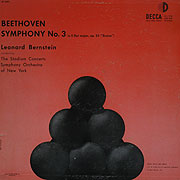 Also hard to reconcile with his later metronome specifications is the review of the premiere, which complained that the work lasted a full hour; frankly, that seems hard to accept at face value unless there were extremely long breaks between movements, as very few recordings, even at the increasingly slow tempos that have become the norm nowadays, approach that length.) Others try to avoid disrespecting the composer’s directive and evolving esthetic outlook by speculating that his metronome was defective. Also hard to reconcile with his later metronome specifications is the review of the premiere, which complained that the work lasted a full hour; frankly, that seems hard to accept at face value unless there were extremely long breaks between movements, as very few recordings, even at the increasingly slow tempos that have become the norm nowadays, approach that length.) Others try to avoid disrespecting the composer’s directive and evolving esthetic outlook by speculating that his metronome was defective.
Further doubt arises from the many errors that Beethoven acknowledged in the printed scores of his works, including both doubling and halving his intended tempos. William C. Newman attributes much of this to stray marks on the autographs, which could suggest a flag (thus converting a quarter note to an eighth note) or only partially filling in a note itself (thus confusing quarter and half notes). One particular instance of this may have occurred at the coda of the Eroica finale, which Beethoven marks as presto (quick) but designates as 116 eighth notes to the minute, a pace that is no quicker than the preceding poco andante section and brings the piece to a rather lumbering and turgid conclusion. Nearly all conductors take this section at twice (or even greater) than the specified pace, as if the proper intent were 116 quarter notes per minute.
Admittedly, there are valid esthetic reasons for taking the Eroica at a far slower pace. At Beethoven’s speed, the opening movement loses all sense of gravity and evokes a cheerful waltz (although admittedly the density of the material and scoring abrades the jollity of the tempo to create a fascinating tension). The lightening of the funeral march, on the other hand, seems to gain in emotional complexity, tenuously balancing between abject, inchoate grief and the stylized, socially-approved mourning of a formal funeral service. It is also significant that a full orchestra of Beethoven’s time, with about 40 players, was barely half the size of a modern one, and its instruments had a far lighter timbre, thus sounding more convincing at a faster pace.
A related concern is tempo variation, which invokes issues of interpretation. Here, Beethoven’s intent cannot be gleaned from the score itself, as he never qualifies the pace specified at the head of each movement with any indication of acceleration or slackening. Reports of his piano playing suggest that he favored strict tempos. Ries stated that around 1800: “Generally he played his compositions very impetuously but for the most part stayed strictly in time, only infrequently pushing the tempo a little. Occasionally he would retard during a crescendo which created a very beautiful and most remarkable effect.” Of course, individual interpretive touches are far more feasible when playing one’s own compositions on a solo piano than when trying to lead a full ensemble. Yet historians believe that various features, such as fermatas (pauses) and textural shifts (from full orchestral tuttis to solo or lightly-scored passages) lent themselves naturally to sections of slower pacing.
Presumably, as used in his context, Reis intended “impetuously” to refer to phrasing and dynamics rather than tempo. Indeed, Beethoven struck many contemporary observers as a highly expressive conductor. Louis Spohr recalled in his 1861 autobiography: “Beethoven was wont to give the signs of expression to his orchestra by all manner of extraordinary motions of his body. Whenever a sforzando occurred, he flung his arms wide, previously crossed upon his breast. At a piano he bent down, and all the lower in proportion to the softness of tone he wished to achieve. Then when a crescendo came he would raise himself again by degrees and upon the commencement of the forte he would spring bolt upright.” Yet Beethoven was known to deride unduly rigid pacing of his work.
An immediate challenge for conductors is presented with the first two notes.

The opening |
The score gives no indication that they should be played other than in tempo with the rest of the movement. Yet, they do serve a special function and, as documented by Grunin, the vast majority of conductors slow them down as much as 60%, so as to magnify their feeling of weight and authority. Ironically, the most extreme instances are from such literalists as Toscanini, Reiner and Ansermet. Most conductors decelerate the notes only slightly, and only a few accelerate the opening chords, as if to lend them added urgency, but rarely by more than 10%, so the impact is barely noticeable. Grunin notes that a disproportionate majority of the extremists are non-German.
Indeed, the very notion of whether the score should be considered as sacrosanct is called into question by a passage at measures 654-657 of the first movement.

The trumpet part, mm 654-7 |
There, the various editions of the Eroica (including both relatively early ones by Farreure (Paris, 1835) and Litolff (1865) as well as the authoritative modern Eulenburg (1925)) consistently give the trumpet passage as shown in the illustration: presenting only the first six notes of the theme, which immediately is abandoned and drops down to repeated harmonic b-flats. As heard, the passage is a severe letdown – the trumpet figure would be the final, triumphant iteration of the theme but instead abruptly cuts out, leaving the rest of the phrase to the far less emphatic soft winds. To sustain the mood, every conductor I have ever heard (other than Scherchen, Monteux and the original instrument ensembles) allows the trumpet to complete the phrase with high b-flats, and then to repeat it a tone higher, thus providing a victorious outburst and leading smoothly in to the final harmonic shift before the conclusion. This raises two questions. First – why did Beethoven do this? Was it to spare his trumpeters the difficulty of hitting a tough note at the top of the range of their “natural” (unkeyed) instruments? Yet Haydn had written not only the high b-flat required to complete Beethoven’s phrase but a d-flat even higher above the treble clef in his 1796 Trumpet Concerto for the same solo E-flat instrument, so this clearly was not an impossible note to play at the time. And second – even if Beethoven intended this, why should modern trumpeters “correct” the score to adjust to their expanded capacities? 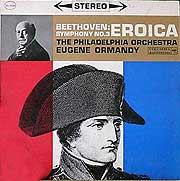 While the effect may “sound better” to modern ears and take advantage of subsequent developments in the manufacture of brass instruments, it falsifies the sound that Beethoven specified – after all, if he had wanted to blast out the full theme at this point, he could have assigned the role to the massed violins (or insisted upon a capable trumpeter), but he clearly chose not to. Nikolaus Harnoncourt goes further to suggest that through this passage Beethoven intended to symbolize that his hero had failed: “If the ‘victory note’ is not heard radiantly but instead is taken up quietly by the flute and then the strings, … this [is] an important statement about the content of the music and not as something that can be eliminated by retouching.” While the effect may “sound better” to modern ears and take advantage of subsequent developments in the manufacture of brass instruments, it falsifies the sound that Beethoven specified – after all, if he had wanted to blast out the full theme at this point, he could have assigned the role to the massed violins (or insisted upon a capable trumpeter), but he clearly chose not to. Nikolaus Harnoncourt goes further to suggest that through this passage Beethoven intended to symbolize that his hero had failed: “If the ‘victory note’ is not heard radiantly but instead is taken up quietly by the flute and then the strings, … this [is] an important statement about the content of the music and not as something that can be eliminated by retouching.”
That, in turn, raises an underlying issue of authenticity. While Beethoven cursed his deafness as a personal blight, it proved a fabulous gift to mankind. Martin notes that, as his hearing faded, Beethoven substituted his imagination for the actual sounds he could no longer hear. As a result, he wrote music far more advanced than any musician of his time was comfortable playing or was apt to accept. Indeed, descriptions of his conducting suggest a level of frustration in attempting to coax riveting performances out of the poorly prepared pick-up groups he invariably had to lead through unfamiliar and difficult music. Perhaps Beethoven conceived and “heard” the Eroica in a way far removed from the thin, reedy, under-rehearsed sounds that the only ensembles he knew could produce. In that light, how an orchestra of Beethoven’s time would have played the Eroica seems utterly irrelevant. Were he and his hearing to be miraculously resurrected in our time, Beethoven just might rejoice and marvel over the precision, authority, power and richness of a modern ensemble – and the myriad interpretive possibilities such expanded resources allow in order to realize a sonic ideal that he could only imagine. Thus, to rule out any interpretive approach as inauthentic merely cheapens the range and intricacy of this masterwork and the astounding prescience of its creator.
 The acoustical era saw only two complete recordings of the Eroica, both made in Berlin in the final year of that technology. The acoustical era saw only two complete recordings of the Eroica, both made in Berlin in the final year of that technology.
- Frieder Weissmann, Berlin State Opera Orchestra (1924; an MP3 file of the first movement is on the Eroica Project website) – By the time of this recording, perhaps Weissmann (1893 – 1984) was too young to have developed an interpretive personality; the Center for the History and Analysis of Recorded Music summarizes his qualifications as “a completely reliable house conductor for whom the recording process held no terrors.” He leads a sensibly-paced reading with neither quirks nor insights, although we hear a presumably common affectation of the time – to drastically slow the tempo for the lyrical second subject – as well as a bizarre mannerism – suddenly galloping off as the mood turns stormy in the middle of the development and then calming down as it subsides.
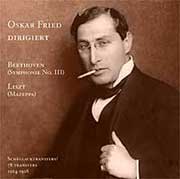 Curiously, the texture is more akin to Viennese light music, with syrupy violins sliding among their notes, as well as tubas chugging away in deference to the demands of the recording horn. The pickup, at least in the MP3 transfer, is noisy and muffled. This is more a curiosity than a yardstick of interpretation of the time. Curiously, the texture is more akin to Viennese light music, with syrupy violins sliding among their notes, as well as tubas chugging away in deference to the demands of the recording horn. The pickup, at least in the MP3 transfer, is noisy and muffled. This is more a curiosity than a yardstick of interpretation of the time.
- Oscar Fried, Berlin Philharmonic (1924, Music and Arts CD) – The remarkably fine recording quality alone makes this reading far more enjoyable, as it clearly displays balances, timbres, inner voices and a decent dynamic range that acoustical recordings all too often obscure. Beyond that, it exploits the constraints of the acoustical mechanism, as the small ensemble lends the work an uncommon intimacy, even at the expense of shrinking its inherent power. Reorchestration is fairly subtle – except at the very opening, as the cello melody is given to a bassoon. Fried was an iconoclast who left us remarkably uninhibited recordings of the Mahler Resurrection, Tchaikovsky Sixth and Berlioz Fantastique symphonies. Yet, perhaps out of respect for its exalted status, his Eroica is relatively chaste, with far less waywardness than Weissmann. Indeed, his tempos seem rather schematic – speeding up for tutti, slowing for solos, but all moderate and sensible within the overall architecture.
The first decade of the electrical era gave us seven fine Eroicas.
- Sir Henry Wood, the Queens Hall Orchestra (1926, Beulah CD) – This bracing account serves to emphasize the sea-change wrought by electrical recording. Although the bass could be riper, and the highest overtones are lacking, the other textures are fully evident and the interplay of balances displays Beethoven’s fine orchestration. Tempos are swift and mostly steady, shorn of German inflection (but with that characteristic slowdown for the first movement lyric theme, over which the ensemble falters), and with an especially rollicking and fleet scherzo (but a more reserved trio). Indeed, the overall 42½ minute pace is consistently exhilarating without crossing the line into frantic or outrunning the players’ ability to hang together – right up to the finale coda, which Wood takes at nearly Beethoven’s prescribed formal pace. First movement tempos tend to collide across the side changes (although this was irrelevant at the time, when each segment had to be played back separately).
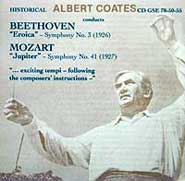 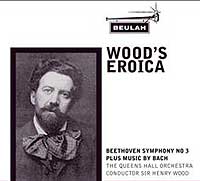 To Wood and the Queens Hall Orchestra goes the historical honor of having been the first conductor and ensemble to have remade an earlier version of the Erioca – in this case, a 1922 Columbia set severely cut by nearly half its length to fit onto six 78 rpm sides. While the scherzo survives basically intact, the finale is trimmed to a mere four minutes, including room for Wood's deliberate coda. Although the playing often lapses into insecurity, the recording is remarkably rich and well-balanced for its time. To Wood and the Queens Hall Orchestra goes the historical honor of having been the first conductor and ensemble to have remade an earlier version of the Erioca – in this case, a 1922 Columbia set severely cut by nearly half its length to fit onto six 78 rpm sides. While the scherzo survives basically intact, the finale is trimmed to a mere four minutes, including room for Wood's deliberate coda. Although the playing often lapses into insecurity, the recording is remarkably rich and well-balanced for its time.
- Albert Coates, London Symphony Orchestra (1926; Claremont CD) – Speaking of speed, and in keeping with the consistent brilliance of his other recordings, Coates leads a compelling performance that clocks in at 41½ minutes. The 12-minute first movement (without the exposition repeat) would meet Beethoven’s metronome marking were it not for tasteful deceleration as the texture thins. Although he plunges ahead fearlessly, and creates a thrilling sense of sheer velocity, a problem quickly emerges – even an expert orchestra, far better prepared than any Beethoven could have faced, can barely keep pace and many details become blurred. Yet, the rich sonority forestalls any sense of trivializing. After a rather traditional funeral march, the scherzo whirls by in a mere 3:50 (without the repeat) – the fastest on record, but here the players really can’t sustain the breathless tempo. Even so, the effect is one of unstoppable, concentrated energy and is truly invigorating, and the musicians’ difficulty generates a wholly appropriate sense of struggle.
- Max Von Schillings, Vienna State Opera Orchestra (1929) – Unfortunately, politics and aesthetics don’t always coincide. Reportedly, Von Schillings was an ardent Nazi and anti-Semite who purged many Jewish musicians during his brief tenure as president of the Prussian Academy of Arts. (Grunin quips: “his timely death (in 1933) saved him from gross infamy, relegating him instead to general obscurity.”) Yet, his reading is patient, thoughtful and quite sensitive, with lovely shaping of phrases, especially in the lyrical sections of the development, and without the cloying mannerisms of Weissmann. More important, he had deep roots in 19th century tradition and taught not only Weissmann but Wilhelm Furtwängler, whose interpretations of the Eroica are supreme. Indeed, his famous student’s approach is clearly rooted in his tenuous balance between impulsive tempo variation and firm control, careful balances, colorful phrasing and ardent sincerity.
- Hans Pfitzner, Berlin Philharmonic (1929, Naxos Historical CD) – This set was a landmark, as it was part of the first complete Beethoven symphony cycle on record, although it missed its goal of marking the 1927 centenary of the composer’s death.
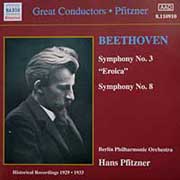 While the symphonies were parceled out among Pfitzner (#s 1, 3, 4, 6 and 8), Fried (# 9), Erich Kleiber (# 2) and Richard Strauss (#s 5 and 7), the choice of Pfitzner (1869 – 1949) for the Eroica was propitious. Not only were his roots deeply anchored in German tradition, but he was an esteemed composer, who brought a creator’s sense and confidence to his conducting of others’ music. Here, he takes a much freer hand than any of his predecessors had done, to create a sense of drama. The opening movement is in constant flux but within a range of moderation, the funeral march is especially expressive, its feeling of numb sorrow suddenly dissolved by a rapid major fugal section that begins softly but then blossoms in abundant hope, the scherzo (shorn of repeats) pauses dramatically to emphasize the weight of a far more measured trio section; and the allegro molto of the finale displays a wide range of mood, with an unexpectedly hushed and slow beginning (although much of the impact is lost by slipping beneath the surface noise). Yet, notwithstanding Pfitzner’s efforts to shape the work for added meaning, his efforts seem compromised by curiously inexpressive playing throughout. While the symphonies were parceled out among Pfitzner (#s 1, 3, 4, 6 and 8), Fried (# 9), Erich Kleiber (# 2) and Richard Strauss (#s 5 and 7), the choice of Pfitzner (1869 – 1949) for the Eroica was propitious. Not only were his roots deeply anchored in German tradition, but he was an esteemed composer, who brought a creator’s sense and confidence to his conducting of others’ music. Here, he takes a much freer hand than any of his predecessors had done, to create a sense of drama. The opening movement is in constant flux but within a range of moderation, the funeral march is especially expressive, its feeling of numb sorrow suddenly dissolved by a rapid major fugal section that begins softly but then blossoms in abundant hope, the scherzo (shorn of repeats) pauses dramatically to emphasize the weight of a far more measured trio section; and the allegro molto of the finale displays a wide range of mood, with an unexpectedly hushed and slow beginning (although much of the impact is lost by slipping beneath the surface noise). Yet, notwithstanding Pfitzner’s efforts to shape the work for added meaning, his efforts seem compromised by curiously inexpressive playing throughout.
- Willem Mengelberg, Philharmonic Symphony Orchestra of New York (1930) – Although it follows in the wake of the Pfitzner approach, this recording is the first Eroica solidly in a proud tradition of deeply personal, proactive interpretation, in which the performers are not mere executants but full-fledged partners in creating an artistic experience. The result is not just another fine performance but a profound emotional encounter that delves beneath the surface of the score. Thus, beginning in the sixth bar of the first movement, tempo is constantly altered to underscore the constantly evolving feeling of the music, and varies from standstill to runaway. In the wrong hands, such activism can seem mechanical, intrusive and unnatural, but under the baton of a master the highlighted details become thoroughly convincing and shed new light on a familiar work. The funeral march is fitful and proceeds through a far wider gamut of thoughts than the standard steady approaches; the relatively staid reading of the scherzo is highlighted by beautifully-shaped, silky-smooth horn textures; and the finale casts each variation in a strikingly different mold, highlighted by an exquisitely gentle and unhurried andante section. Interestingly, Mengelberg is the first to add the luxury of the first movement exposition repeat, an indulgence that would not be heard again on record until the mid-fifties. A 1940 Mengelberg/Concertgebouw concert (Music and Arts CD) is fundamentally similar, but with less subtlety, cruder playing, and, as if to compensate for the most severe sonic shortfall of the earlier set, hugely loud tympani.
  Incidentally, the quality of the New York recording sounds remarkably rich and detailed on my Sirio CD – indeed, suspiciously so for its vintage – so the transfer may have been augmented with considerable computer enhancement. Incidentally, the quality of the New York recording sounds remarkably rich and detailed on my Sirio CD – indeed, suspiciously so for its vintage – so the transfer may have been augmented with considerable computer enhancement.
- Serge Koussevitzky, London Philharmonic (1934, Biddulph CD) – Although the CD notes claim that this performance is highly idiosyncratic, with great interpretive license undreamt of today, it’s barely evident, even in comparison to the those of comparable vintage. Rather, as a complement to the audible passion he brought to many of his other recordings, we can hear the strong sense of respect and morality that infused his conducting and that produced a rather straightforward, but fully sincere, account of a work that fully deserves the pedestal on which he placed it. Most remarkable is the integrity of the finale – the first (and one of the very few) on record that observes the far slower closing consistent with Beethoven’s possibly mistaken metronome marking – not a frantic gallop to the end, but rather a lasting impression of stateliness that perhaps better exemplifies the “heroic” overtones that will forever color our perception of the Eroica. A 1945 remake with the Boston Symphony (RCA LP, Lys CD) is nearly identical but coarser.
- Felix Weingartner, Vienna Philharmonic (1936, Naxos CD) – With Weingartner we come to another milestone – the first Beethoven symphony cycle recorded by a single conductor. While commonplace nowadays – pity the conductor who has issued only one complete cycle – this was a remarkable achievement at the time, although Weingartner’s wasn’t a steady process – prior to this Eroica, he had issued four versions of the Fifth! Weingartner’s Eroica fully exemplifies his reputation for having paved the way to the objective ideals of the 20th century, but with great taste, nobility and moderation – and without a hint of the sobriety or asceticism that has dulled so much modern music-making. His leadership is classical in the sense of averting outbursts or even hints of extreme sentiment, and instead provides a thoroughly convincing sense of sincerity through his dignity and elegance. Thus, his subtly effective funeral march is cast in two mighty arcs, slowly building intensity and then receding back to the initial mood of grave solemnity, followed by a scherzo of uncommon bounce and flair, and concluding with a beautifully-paced and -judged finale.
 Many subsequent recordings of the Eroica are from conductors steeped in German musical traditions. Many subsequent recordings of the Eroica are from conductors steeped in German musical traditions.
- Wilhelm Furtwängler, Vienna Philharmonic (Music and Arts, December 1944) – In his evaluation of all the known Furtwängler performances, John Ardoin cites this as the greatest Eroica on record. I wholeheartedly agree. While others take proactive approaches, Furtwängler presents a stunning confluence of subtle detail that adds astounding extra-musical qualities to enhance Beethoven’s conception – a miracle of the conductor’s art that refutes any notion that the work can play itself on autopilot.
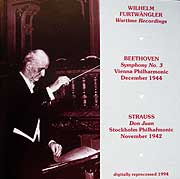 Clearly this arose in large part from its place in a unique vortex of art, history and morality – in the fervent if naïve belief that music could serve as a bulwark to preserve true German culture against the temporary disruption of Nazi repression, alone among his peers of conscience Furtwängler remained behind, but his interpretations increasingly were infused with conflict, misgiving and anguish. Barely a month before learning that he was marked for liquidation by the SS for his disloyalty and fleeing to Switzerland (where he would have to defend charges of collaboration), this Eroica fully reflects Furtwängler’s torment, as the conductor seized upon this vehicle to express the inexpressible. Thus the first movement throbs with palpable yearning, buffeted not only by tempo (and not just speed but rushing or pulling back individual beats) but a complex interplay of attacks, balances, phrasing and accentuation, all exquisitely controlled and treading a precarious line between cultured discipline and the threat of chaos. The second compels a panoply of emotion through its extraordinary layering of textures. He injects doubt and concern into the usual respite of the third, bringing its upbeat trio to a grinding halt and then rushing the end of the following scherzo section with joyless, false optimism. His focus of the finale is not on the vigorous variations but on the adagio, which not only recalls but dwells upon the mournful mood of the funeral march, and concludes with a deliberately attenuated coda, a joyless death-throe drained of any reason for genuine celebration. Furtwängler’s far more famous post-war 1952 Vienna Philharmonic studio version (EMI) is beautifully polished and conveys a fine sense of architecture, but is utterly shorn of the special touches that make his wartime concert so devastatingly effective. In part this stems from his generally dutiful attitude toward getting through recording sessions as efficiently as possible – a Vienna Philharmonic concert three days later (Virtuoso CD) is far more engaged, with especially moving solo statements of the funeral march theme. While it’s unfortunate that we don’t have more Furtwängler Eroicas with the Berlin Philharmonic, with which he had the greatest rapport, a September 1953 Munich concert, released by EMI in its short-lived Great Conductors of the 20th Century series, is intensely massive, weighty and introspective, anchored by potent bass, and abetted by fine sonic quality that displays the mechanics of the playing and compels appreciation for the deeply focused labor and ardent focus in which every note is made to matter. On a slightly lower plane are two fundamentally similar Berlin Philharmonic readings from December 1952 (both on Music & Arts CDs). Clearly this arose in large part from its place in a unique vortex of art, history and morality – in the fervent if naïve belief that music could serve as a bulwark to preserve true German culture against the temporary disruption of Nazi repression, alone among his peers of conscience Furtwängler remained behind, but his interpretations increasingly were infused with conflict, misgiving and anguish. Barely a month before learning that he was marked for liquidation by the SS for his disloyalty and fleeing to Switzerland (where he would have to defend charges of collaboration), this Eroica fully reflects Furtwängler’s torment, as the conductor seized upon this vehicle to express the inexpressible. Thus the first movement throbs with palpable yearning, buffeted not only by tempo (and not just speed but rushing or pulling back individual beats) but a complex interplay of attacks, balances, phrasing and accentuation, all exquisitely controlled and treading a precarious line between cultured discipline and the threat of chaos. The second compels a panoply of emotion through its extraordinary layering of textures. He injects doubt and concern into the usual respite of the third, bringing its upbeat trio to a grinding halt and then rushing the end of the following scherzo section with joyless, false optimism. His focus of the finale is not on the vigorous variations but on the adagio, which not only recalls but dwells upon the mournful mood of the funeral march, and concludes with a deliberately attenuated coda, a joyless death-throe drained of any reason for genuine celebration. Furtwängler’s far more famous post-war 1952 Vienna Philharmonic studio version (EMI) is beautifully polished and conveys a fine sense of architecture, but is utterly shorn of the special touches that make his wartime concert so devastatingly effective. In part this stems from his generally dutiful attitude toward getting through recording sessions as efficiently as possible – a Vienna Philharmonic concert three days later (Virtuoso CD) is far more engaged, with especially moving solo statements of the funeral march theme. While it’s unfortunate that we don’t have more Furtwängler Eroicas with the Berlin Philharmonic, with which he had the greatest rapport, a September 1953 Munich concert, released by EMI in its short-lived Great Conductors of the 20th Century series, is intensely massive, weighty and introspective, anchored by potent bass, and abetted by fine sonic quality that displays the mechanics of the playing and compels appreciation for the deeply focused labor and ardent focus in which every note is made to matter. On a slightly lower plane are two fundamentally similar Berlin Philharmonic readings from December 1952 (both on Music & Arts CDs).
- Oswald Kabasta, Munich Philharmonic (Lys, 1943) – This convincing but rather routine performance is a disappointment, coming from another deeply conflicted conductor who remained throughout the Third Reich (he killed himself after the War) who left us startlingly impassioned wartime Bruckner Ninth and Dvorak New World broadcasts.
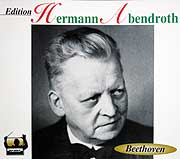 Here, though, he suppresses a sense of personal involvement, which only emerges during a heartfelt finale; otherwise, it’s heavy and powerful, but just not particularly inspired. Here, though, he suppresses a sense of personal involvement, which only emerges during a heartfelt finale; otherwise, it’s heavy and powerful, but just not particularly inspired.
- Hermann Abendroth, Radio Leipzig Symphony (Music and Arts, 1949); Berlin Radio Symphony (Tahra, 1954) – Both Abendroth broadcasts share the same fundamental approach of weightiness competing against urgency, concentrated through emphatic accenting, and boast finales that neatly juxtapose impulsion and repose to summarize the moods of the earlier movements and then end in a startlingly sudden and unprepared race to the end. The former, Abendroth’s first concert as head of the orchestra with which he would close his career, has a special aura of prominent tympani, but with thick and dark coloration to deepen rather than relieve the gravity, and consistent “rolling” of even sharp chords to lend them added import of shifting textures (and slightly delaying the tympani to suggest an added sense of laborious effort, and thus add to the import of the work).
- Otto Klemperer, Philharmonia (EMI, 1959) – What a difference four minutes makes! A mono EMI recording by the same forces barely four years earlier is entirely eclipsed by this more patient unfolding that emphasizes the score’s monumentality, finely complemented by not only the detail of the stereo soundstage but by Klemperer’s placement of the second violins on stage right,
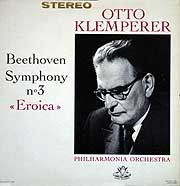 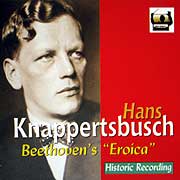 generating a fascinating antiphonal interplay inherent in the scoring but otherwise hidden from most recordings. The cumulative effect is to relieve the work of any sense of torpor despite the leisurely tempos, thus illustrating the impact of texture on the psychology of how we perceive sound (a phenomenon often observed with Toscanini, who was reputed to be a very fast conductor, even though the timings of many of his performances, especially operas, are among the slowest.) generating a fascinating antiphonal interplay inherent in the scoring but otherwise hidden from most recordings. The cumulative effect is to relieve the work of any sense of torpor despite the leisurely tempos, thus illustrating the impact of texture on the psychology of how we perceive sound (a phenomenon often observed with Toscanini, who was reputed to be a very fast conductor, even though the timings of many of his performances, especially operas, are among the slowest.)
- Hans Knappertsbusch, Berlin Philharmonic (Tahra, 1943); Bremen Philharmonic (Tahra, 1951); Munich Philharmonic (Tahra, 1953) – Known for his smooth, temperate unfolding of the German romantics (especially Wagner), Knappertsbusch’s only studio recording of the Eroica (1943) is especially impressive for achieving an organic evolution despite the need to have recorded the work in four-minute fragments. Tempo shifts are subtle and dynamics develop smoothly but everything inexorably builds toward and then away from the funeral march fugue, suggesting Rachmaninoff’s notion that every work has a “point” toward which all elements must aim. His contempt for rehearsals afflicts the Bremen concert with tentative, insecure playing that could be heard as adding an intriguing undercurrent of vulnerability but strikes me as undermining a grim and plodding rendition only occasionally redeemed by insistent brass and a startlingly loud outburst of the first movement recapitulation. The Munich concert, while nearly five minutes faster, sounds more heartfelt with its richer sound, patient continuity, repressed climaxes and carefully controlled tempos to create an overall atmosphere of introspection that deepens the sense of grief in the funeral march.
- Ferenc Fricsay, Berlin Radio Symphony (EMI, 1961) – Here we have an extraordinary yet sad instance in which a conductor’s personal life impacts his interpretation. Only two years earlier, Fricsay led a fairly routine recording with the Berlin Philharmonic (DG). But by early 1961 he was in an all too brief “Indian Summer” between one severe illness and another that would soon kill him. One’s mid-forties is far too soon to confront mortality, yet it forced Friscay to a clarity and spirituality purified by impending doom. Under Friscay’s baton, the entire Eroica becomes a rarified meditation, with slow sections so fragile as to hover in mid-air, the funeral march climaxes emerging through massive struggle, the scherzo a labored respite, and the finale a steadfast resolve to meet fate with dignity and discipline. He “solves” the problem of the first movement trumpet entry by burying the entire outburst deep within the orchestral fabric, as if to insist that it not detract from the texture of life he is weaving. This intimate and deeply personal account is extended with a Leonore Overture from the same sessions in which the opening and the chorales following the famous bugle calls are exquisitely suspended in time, conveying both a brief respite amid the turbulence of the plot, and perhaps a poignant reflection of Fricsay’s outlook at the time.
- Bruno Walter, New York Philharmonic (Lys, 1941); Symphony of the Air (Music & Arts, 1957); Columbia Symphony (Sony, 1958) –
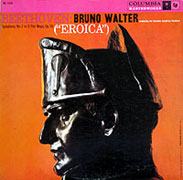 Walter’s first recording of the Eroica, which launched an integral cycle that extended over the next decade, is fluid and organic, reflecting the work’s musical logic, beautifully played (and with fairly crisp attacks) by an orchestra that could produce variable results at the time. Walter’s final Eroica followed a heart attack that changed his outlook and prompted him to rerecord much of his repertoire in stereo using the hand-picked Columbia Symphony Orchestra, whose modest forces were drawn partly from the Los Angeles Philharmonic. Typical of this final phase of his long career, he treats the work as tender, flowing abstract music, emphasizing its sheer beauty and humanity – an approach that works well with Mozart and Brahms (and even much of Beethoven) but overlooks far too much of the Eroica’s revolutionary ardor. A year before, on February 3, 1957, Walter led the Eroica in a memorial tribute to Toscanini in Carnegie Hall with the “Symphony of the Air” – the remnants of Toscanini’s NBC Symphony which the network had disbanded after his 1954 retirement, but which survived for another decade both under guest conductors and in leaderless concerts (and a Roulette recording) intended to preserve the spirit of their departed Maestro. Perhaps in deference to the occasion and the style of his late colleague, Walter crafts a hybrid rendition, combining Toscanini’s steadfast drive (and outsized tympani) with his own patient tempos and humanistic tendencies, and highlighted by an appropriately heartfelt yet rough-hewn and forceful funeral march. Walter’s first recording of the Eroica, which launched an integral cycle that extended over the next decade, is fluid and organic, reflecting the work’s musical logic, beautifully played (and with fairly crisp attacks) by an orchestra that could produce variable results at the time. Walter’s final Eroica followed a heart attack that changed his outlook and prompted him to rerecord much of his repertoire in stereo using the hand-picked Columbia Symphony Orchestra, whose modest forces were drawn partly from the Los Angeles Philharmonic. Typical of this final phase of his long career, he treats the work as tender, flowing abstract music, emphasizing its sheer beauty and humanity – an approach that works well with Mozart and Brahms (and even much of Beethoven) but overlooks far too much of the Eroica’s revolutionary ardor. A year before, on February 3, 1957, Walter led the Eroica in a memorial tribute to Toscanini in Carnegie Hall with the “Symphony of the Air” – the remnants of Toscanini’s NBC Symphony which the network had disbanded after his 1954 retirement, but which survived for another decade both under guest conductors and in leaderless concerts (and a Roulette recording) intended to preserve the spirit of their departed Maestro. Perhaps in deference to the occasion and the style of his late colleague, Walter crafts a hybrid rendition, combining Toscanini’s steadfast drive (and outsized tympani) with his own patient tempos and humanistic tendencies, and highlighted by an appropriately heartfelt yet rough-hewn and forceful funeral march.
 Here is a sampling of Eroicas from conductors largely independent from German tradition: Here is a sampling of Eroicas from conductors largely independent from German tradition:
- Arturo Toscanini, NBC Symphony (RCA, 1953) – Critics often used to juxtapose Furtwängler and Toscanini as opposite poles of Beethoven interpretation, and there’s some truth to that comparison (although it reflects a sad ignorance of their predecessors). His most extraordinary Eroica was his last, a 1953 concert that exemplifies the extreme simplification of his style toward the end of his 60-year career.
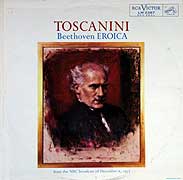  Nearly entirely devoid of rhetoric, this is a reading of unrivalled purity in which all elements flow together into an integral tapestry of life. As if to illustrate the quip about tradition being the last bad performance, here Toscanini discards convention almost entirely, barely slowing for the second theme and development of the first movement, as every other conductor had done before him – including his own earlier recordings. While I generally shun his late recordings as too rigid, here the concentration is compelling, and the few personal touches – a lovely oboe figure in the funeral march, some inflection in the trio horns – are all the more effective. The finale, especially, is played with extraordinary verve, and its youthful invention leaps off the page. Toscanini’s only studio recording of the Eroica, from 1949 (RCA), is similar, but with slightly more incisive edges and repressed tympani. A fascinating comparison arises in a 1939 concert (superbly restored on Music and Arts CD), which hints at a far more personal earlier style. (Indeed, Christopher Dyment notes that in 1930 and 1937 Eroica concerts Toscanini’s funeral marches lasted nearly 20 minutes, as compared to his “standard” on records of about 14½.) The 1939 concert begins with the opening chords taken more slowly (and hence out of tempo) than nearly any other conductor on record and proceeds with abundant drama and flexibility, culminating in a boldly-conceived finale. Also notable is a concert that neatly bridges the two styles and forms an absorbing counterpart to the Furtwängler 1944 reading – a broadcast given on September 1, 1945 in celebration of V-J Day and the end of World War II (Music and Arts CD, which pairs it with an ecstatic Beethoven Fifth broadcast on V-E Day). Although Toscanini fought fascism largely from the safe harbor of the free world, he was among its most vocal challengers and his emotions surely guided this occasion, seizing upon the Eroica to symbolize mixed feelings of the War’s sacrifices, losses and ultimate success. Nearly entirely devoid of rhetoric, this is a reading of unrivalled purity in which all elements flow together into an integral tapestry of life. As if to illustrate the quip about tradition being the last bad performance, here Toscanini discards convention almost entirely, barely slowing for the second theme and development of the first movement, as every other conductor had done before him – including his own earlier recordings. While I generally shun his late recordings as too rigid, here the concentration is compelling, and the few personal touches – a lovely oboe figure in the funeral march, some inflection in the trio horns – are all the more effective. The finale, especially, is played with extraordinary verve, and its youthful invention leaps off the page. Toscanini’s only studio recording of the Eroica, from 1949 (RCA), is similar, but with slightly more incisive edges and repressed tympani. A fascinating comparison arises in a 1939 concert (superbly restored on Music and Arts CD), which hints at a far more personal earlier style. (Indeed, Christopher Dyment notes that in 1930 and 1937 Eroica concerts Toscanini’s funeral marches lasted nearly 20 minutes, as compared to his “standard” on records of about 14½.) The 1939 concert begins with the opening chords taken more slowly (and hence out of tempo) than nearly any other conductor on record and proceeds with abundant drama and flexibility, culminating in a boldly-conceived finale. Also notable is a concert that neatly bridges the two styles and forms an absorbing counterpart to the Furtwängler 1944 reading – a broadcast given on September 1, 1945 in celebration of V-J Day and the end of World War II (Music and Arts CD, which pairs it with an ecstatic Beethoven Fifth broadcast on V-E Day). Although Toscanini fought fascism largely from the safe harbor of the free world, he was among its most vocal challengers and his emotions surely guided this occasion, seizing upon the Eroica to symbolize mixed feelings of the War’s sacrifices, losses and ultimate success.
- Hermann Scherchen, Vienna State Opera Orchestra (Westminster, 1958) – Taking Toscanini’s objective approach to the extreme,
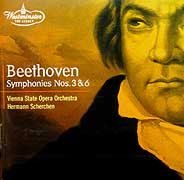 Scherchen turns in the fastest Eroica on record. The opening movement seems wildly fast, yet it’s still a half-minute slower than Beethoven specified. Even so, the deluge of notes and sheer momentum suggest the unhinged sanity and frightening impact that the first audiences must have felt. Further visceral excitement arises from the players’ inability to cleanly articulate the more congested passages. Another touch of authenticity – this is also the first recording to play the trumpet figure in the first movement coda as Beethoven had written it. After such rapidity, the funeral march seems a return to reality and thoughtfulness, the drum-enforced downbeats of the central fugue suggesting defiance of the torpor of aging and a protest against the inertness of death, which renders the submission of the end especially poignant. A conventionally-paced scherzo leads to a vertiginous finale which contains one more shock – a huge pause that sets up an adagio section at barely half the specified pace, which then plunges into a frenzied coda. More than any other recording, Scherchen’s displays the revolutionary nature of the Eroica in a way at which ears accustomed to the work can still marvel. (The current CD pairs the Eroica with Scherchen’s equally breathless gallop through the Pastorale Symphony.) Scherchen turns in the fastest Eroica on record. The opening movement seems wildly fast, yet it’s still a half-minute slower than Beethoven specified. Even so, the deluge of notes and sheer momentum suggest the unhinged sanity and frightening impact that the first audiences must have felt. Further visceral excitement arises from the players’ inability to cleanly articulate the more congested passages. Another touch of authenticity – this is also the first recording to play the trumpet figure in the first movement coda as Beethoven had written it. After such rapidity, the funeral march seems a return to reality and thoughtfulness, the drum-enforced downbeats of the central fugue suggesting defiance of the torpor of aging and a protest against the inertness of death, which renders the submission of the end especially poignant. A conventionally-paced scherzo leads to a vertiginous finale which contains one more shock – a huge pause that sets up an adagio section at barely half the specified pace, which then plunges into a frenzied coda. More than any other recording, Scherchen’s displays the revolutionary nature of the Eroica in a way at which ears accustomed to the work can still marvel. (The current CD pairs the Eroica with Scherchen’s equally breathless gallop through the Pastorale Symphony.)
- Sergiu Celibidache, Munich Philharmonic (EMI, 1987) – At the opposite end of the temporal scale,
 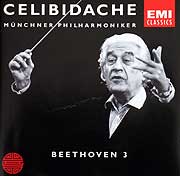 Celibidache takes the equivalent of a full hour (had he taken the first movement repeat), and, perhaps unwittingly, his coda is one of the very few to match Beethoven’s tempo. His patient, steady pacing, combined with his deliberate attenuation of the dynamic range, deprives the work of any sense of energy or contrasting moods. Yet, in its place Celibidache paints a sonic portrait of deep concentration and pure intellect that compels attention to the work’s underlying structure and connects the movements into a single sweep of uniform atmosphere, thus seemingly symbolizing his Zen beliefs. Celibidache takes the equivalent of a full hour (had he taken the first movement repeat), and, perhaps unwittingly, his coda is one of the very few to match Beethoven’s tempo. His patient, steady pacing, combined with his deliberate attenuation of the dynamic range, deprives the work of any sense of energy or contrasting moods. Yet, in its place Celibidache paints a sonic portrait of deep concentration and pure intellect that compels attention to the work’s underlying structure and connects the movements into a single sweep of uniform atmosphere, thus seemingly symbolizing his Zen beliefs.
- John Barbirolli, BBC Symphony (EMI, 1967) – Barbirolli presents a fascinating combination of tempos as nearly as slow as Celibidache’s but with a bright, transparent sonority. (The scherzo, normally-paced, although suitably joyous, seems a bit out of place in the overall scheme.) The result is to invest the work with a deeply human glow, suggesting pensiveness rather than brooding, and empathy rather than a stern challenge.
- George Szell, Cleveland Symphony (Columbia LP, Sony CD, 1958) – Szell achieves a comparable feat with extremely precise playing and sharp articulation, so that his moderate tempos suggest weight lacking in the rather classical performance itself. The rigidity of the funeral march adds a sense of grim determination, lightened by the instrumental details that emerge.
 
- Erich Kleiber, Concertgebouw (Decca, 1950) – While the interpretation is much praised, for me the real star of this show is Decca’s justly acclaimed “full frequency range recording,” which, even in its monaural sound, enabled listeners to appreciate the interplay of instruments and their textures and thus foster appreciation for the effectiveness of Beethoven’s orchestration, which often is unfairly maligned as merely functional, as if that were a problem – the alternative would have been a showy display that would have detracted from the need to express his ideas in the most direct and efficient way.
- Antal Dorati, Minneapolis Symphony (Mercury, 1957) – Dorati’s is a sharp, no-nonsense reading with prominent, insistent tympani adding both thrust and an appropriate suggestion of militarism. A sense of urgency drives a riveting finale with clipped notes toward the end of the adagio section.
- Herbert von Karajan, Berlin Philharmonic (DG, 1962) – Although Toscanini is routinely cited as the polar opposite of Furtwängler’s probing for inner meaning, I would opt for von Karajan’s obsession with mechanical perfection and surface polish.
  While the result often strikes me as cold and calculating (and thus antithetical to the purpose of great music), in this second, and generally most admired, of his four (!) cycles, the Berlin Philharmonic’s superlative playing and finely graded dynamics and textures combine with von Karajan’s severe, unyielding, focused energy for a highly effective Eroica. The highlight is the funeral march, which emerges as hugely powerful through its sheer stoicism and dignity. Ironically, the result is to make the Eroica a participatory experience that requires us to complete Beethoven’s magnificent conception with our own feelings, thus creating a more personal and involving immersion than merely listening to others’ playing would do. While the result often strikes me as cold and calculating (and thus antithetical to the purpose of great music), in this second, and generally most admired, of his four (!) cycles, the Berlin Philharmonic’s superlative playing and finely graded dynamics and textures combine with von Karajan’s severe, unyielding, focused energy for a highly effective Eroica. The highlight is the funeral march, which emerges as hugely powerful through its sheer stoicism and dignity. Ironically, the result is to make the Eroica a participatory experience that requires us to complete Beethoven’s magnificent conception with our own feelings, thus creating a more personal and involving immersion than merely listening to others’ playing would do.
- Leonard Bernstein; Stadium Concerts Symphony Orchestra of New York (1953, Decca LP, DG CD); New York Philharmonic (1965, Columbia LP, Sony CD); Vienna Philharmonic (1979, DG) – Bernstein’s recordings come from the three phases of his career. The first, toward the end of his first decade of guest conducting, was with the summer incarnation of the New York Philharmonic, where his career began and of which he became the permanent conductor; both are similar, displaying full confidence and maturity (and the latter with a cover layout nearly as egotistical as von Karajan's) but played with just enough of an edge to inject some visceral excitement into otherwise standard readings. The Vienna recording, like all of his post-Philharmonic work, is somewhat slower, especially in its funeral march, which provides a striking and wholly appropriate bridge of grueling, numb grief between the energy of the opening and the soothing respite of the scherzo.
Other standard recordings that are largely idiomatic yet lack the special touches, insights and bold, personal interpretations of those noted above include: Karl Bohm and the Vienna Philharmonic (DG, 1972 – beautifully played, with all the standard traditional German tempos and inflections, and with a moving funeral march); Carlo Maria Giulini and the Los Angeles Philharmonic (DG, 1979 – in which drama is eschewed in favor of, as the liner notes state, tempos slow enough to enable the musicians to breathe and find a natural diction for the extraordinary profusion of ideas proposed by Beethoven that need space to develop); Fritz Reiner and the Chicago Symphony (RCA, 1955 – with an especially brisk finale); Victor de Sabata and the London Philharmonic (Decca, 1945 – Toscanini’s successor at La Scala, known mostly for operas, with especially wide dynamics for 78s); Erich Leinsdorf and the Boston Symphony – slow and stately (as indeed one would expect from the "Aristocrat of Orchestras"); Ernest Ansermet and l'Orchestre de la Suisse Romande (Decca, 1960); Charles Munch and the Boston Symphony (RCA LP, 1957); Pierre Monteux and the Concertgebouw (1962, Philips – adhering to the correct trumpet drop-down); Erich Leinsdorf and the Rochester (1953, Columbia LP); William Steinberg and the Pittsburgh Symphony (1963, Command); and Leopold Stokowski and the London Symphony (RCA, 1974 – although the orchestra seems on autopilot [a Coriolan Overture from the same session is far more vital] this was Stokowski’s first and only Eroica – at the age of 93, which fact alone qualifies it for the record books).
 While recordings that attempt to evoke the sound of Beethoven’s era with the actual instruments (or replicas) and authentic playing techniques of the time have their fans and detractors (mostly the latter), in this instance their efforts go well beyond mere historical curiosity. While recordings that attempt to evoke the sound of Beethoven’s era with the actual instruments (or replicas) and authentic playing techniques of the time have their fans and detractors (mostly the latter), in this instance their efforts go well beyond mere historical curiosity. 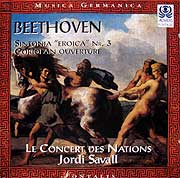 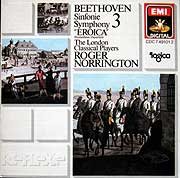 Here was a work that either thrilled or shocked every listener, and so it seems especially appropriate to present it in its intended context in order to replicate its extraordinary impact. At least in terms of tempo Coates, Scherchen and a few others had come quite close, but within the confines of their standard modern orchestras. In the 1980s a movement arose that sought a higher degree of purity by using not only authentic instruments but also the lower pitch (a=430), untempered tuning, gut strings, articulation, balances, dynamics and timbres of 200 years ago. The first to appear, in August, 1985, was by Christopher Hogwood and the Academy of Ancient Music (Oiseau-Lyre). The Fall of 1987 brought three more by
Roy Goodman and the Hanover Band (Nimbus), Hans Brüggens and the Orchestra of the 18th Century (Philips) and Roger Norrington and the London Classical Players (EMI). While they all had the same goal, there were some notable differences. Hogwood conducted from the pianoforte (as was done at the time, although the concertmaster violinist could lead as well) even though he can’t be heard through the crisp articulation, firm tympani and powerful winds. Goodman’s playing is rather rough (perhaps giving a more authentic image of how Beethoven's under-rehearsed pickup groups might have sounded) and its reverberant ambience is derived from having been recorded in a church (thus replicating the much smaller, livelier halls of the time). To the Norrington account fell the distinction of being roundly savaged by most critics due to its rigid tempos that were considerably faster than the others; yet even at 43½ minutes it fell well short of Beethoven’s metronome markings. For me, the best of all of these was worth waiting for – a truly startling account by Jordi Savall and Le Concert des Nations (1994, Auvidis) which treads a precariously thin line between barely comforting control and wild abandon through aggressive phrasing and accentuation, constantly chafing forward with palpable enthusiasm, and a militaristic funeral march that throbs with insistent, painful outbursts. Here was a work that either thrilled or shocked every listener, and so it seems especially appropriate to present it in its intended context in order to replicate its extraordinary impact. At least in terms of tempo Coates, Scherchen and a few others had come quite close, but within the confines of their standard modern orchestras. In the 1980s a movement arose that sought a higher degree of purity by using not only authentic instruments but also the lower pitch (a=430), untempered tuning, gut strings, articulation, balances, dynamics and timbres of 200 years ago. The first to appear, in August, 1985, was by Christopher Hogwood and the Academy of Ancient Music (Oiseau-Lyre). The Fall of 1987 brought three more by
Roy Goodman and the Hanover Band (Nimbus), Hans Brüggens and the Orchestra of the 18th Century (Philips) and Roger Norrington and the London Classical Players (EMI). While they all had the same goal, there were some notable differences. Hogwood conducted from the pianoforte (as was done at the time, although the concertmaster violinist could lead as well) even though he can’t be heard through the crisp articulation, firm tympani and powerful winds. Goodman’s playing is rather rough (perhaps giving a more authentic image of how Beethoven's under-rehearsed pickup groups might have sounded) and its reverberant ambience is derived from having been recorded in a church (thus replicating the much smaller, livelier halls of the time). To the Norrington account fell the distinction of being roundly savaged by most critics due to its rigid tempos that were considerably faster than the others; yet even at 43½ minutes it fell well short of Beethoven’s metronome markings. For me, the best of all of these was worth waiting for – a truly startling account by Jordi Savall and Le Concert des Nations (1994, Auvidis) which treads a precariously thin line between barely comforting control and wild abandon through aggressive phrasing and accentuation, constantly chafing forward with palpable enthusiasm, and a militaristic funeral march that throbs with insistent, painful outbursts.
1990 brought a new development – a hybrid approach that combined the techniques of Beethoven’s era with the clout of the modern orchestra. 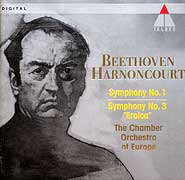 The first to take this tack was Nikolaus Harnoncourt and the Chamber Orchestra of Europe (Teldec) (although he used the old natural trumpets, as he felt that modern ones would have overwhelmed the fabric), followed by John Eliot Gardiner and the Orchestre Révolutionnnaire et Romantique (1993, Archiv). Rather than a violation of form, perhaps this is the best way to present the Eroica with validity for our time. Whether due to his affliction or his astounding creativity and foresight, Beethoven wrote far more into his Eroica than any orchestra of his time possibly could have communicated. This isn’t mere conjecture – the proof lies in the extraordinary realm of the deeply affecting – and equally valid – recorded interpretations we have already noted. It seems inconceivable that Beethoven would preferred the thin, tentative strains of the few performances he heard to the spectacular sounds he could only have imagined – realized by the fertile tonal resources and sheer power of a modern orchestra. Moreover, it’s futile to ignore what we know – with all due respect to scholarly recreations, a modern audience is more moved by this soul-stirring music in the context to which we have become accustomed. The first to take this tack was Nikolaus Harnoncourt and the Chamber Orchestra of Europe (Teldec) (although he used the old natural trumpets, as he felt that modern ones would have overwhelmed the fabric), followed by John Eliot Gardiner and the Orchestre Révolutionnnaire et Romantique (1993, Archiv). Rather than a violation of form, perhaps this is the best way to present the Eroica with validity for our time. Whether due to his affliction or his astounding creativity and foresight, Beethoven wrote far more into his Eroica than any orchestra of his time possibly could have communicated. This isn’t mere conjecture – the proof lies in the extraordinary realm of the deeply affecting – and equally valid – recorded interpretations we have already noted. It seems inconceivable that Beethoven would preferred the thin, tentative strains of the few performances he heard to the spectacular sounds he could only have imagined – realized by the fertile tonal resources and sheer power of a modern orchestra. Moreover, it’s futile to ignore what we know – with all due respect to scholarly recreations, a modern audience is more moved by this soul-stirring music in the context to which we have become accustomed.
An intriguing further step came from David Zinman and the Tonhalle Orchestra Zurich (1998, Arte Nova). Beyond a fine, vigorous reading on modern instruments, Zinman presented the first recording of a new Bärenreiter Urtext edition of the Beethoven symphonies based on original sources,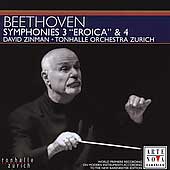 with their inevitable ambiguities and inconsistencies resolved on the basis of stylistic practices of the time. Aside from repeating the entire final section of the scherzo, there are no major structural changes. Yet the result is enormous fun for those who know the standard version of the Eroica by heart. The new edition enlivens the work with occasional but fascinating details – some clipped notes, aggressive tympani figures, modified phrasing and rebalanced sonorities in the opening movement; grace notes that lighten the theme of the funeral march and flourishes that add character to its fugue; oboe embellishments throughout; and thinning the texture down to a solo violin for one of the variations of the finale. While none of these touches alters our understanding of the work, they do compel renewed appreciation of a work we have come to take for granted by inviting us to listen closely with new ears, and thus creating a fresh and stimulating experience and edging us ever closer to the revolution launched by Beethoven’s Eroica symphony. with their inevitable ambiguities and inconsistencies resolved on the basis of stylistic practices of the time. Aside from repeating the entire final section of the scherzo, there are no major structural changes. Yet the result is enormous fun for those who know the standard version of the Eroica by heart. The new edition enlivens the work with occasional but fascinating details – some clipped notes, aggressive tympani figures, modified phrasing and rebalanced sonorities in the opening movement; grace notes that lighten the theme of the funeral march and flourishes that add character to its fugue; oboe embellishments throughout; and thinning the texture down to a solo violin for one of the variations of the finale. While none of these touches alters our understanding of the work, they do compel renewed appreciation of a work we have come to take for granted by inviting us to listen closely with new ears, and thus creating a fresh and stimulating experience and edging us ever closer to the revolution launched by Beethoven’s Eroica symphony.
 The primary sources to which this article is indebted are as follows: The primary sources to which this article is indebted are as follows:
- George Grove: Beethoven and His Symphonies (Novella, Ever & Company, 1898; reprint: Dover, 1962) – Concise but hugely informative, Grove’s study remains unique for its combination of scholarship, analysis, insight and sheer readability.
- H.C. Robbins, ed: Beethoven – A Documentary Study – valuable contemporaneous reviews and accounts by associates. (Thames & Hudson, 1970)
- Scott Burnham: Beethoven Hero (Princeton University, 1995)
- Lewis Lockwood: Beethoven – Studies in the Creative Process (Harvard University, 1992)
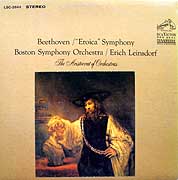
- Paul Henry Lang: Music in Western Civilization (Norton, 1941)
- Maynard Solomon: Beethoven (Schirmer, 1977; rev 1998).
- Robert Aaron Schauffler: Beethoven – The Man Who Freed Music (Tudor Publishing, 1947)
- Notes to the following Eroica LPs:
- Frank Homes – Klemperer/Philharmonia (Angel S-35853, 1961)
- B. F. Martin – Bernstein/NY Philharmonic (Columbia MS-6774, 1965)
- Klaus George Roy – Szell/Cleveland (Epic BC-1001, 1958)
- William Flanagan – Bernstein/Stadium Concerts Symphony of NY (Decca DL-9697, 1953)
- Edward Tatnall Canby – Ristenpart/South German Philharmonic (Checkmate C-76003)
- William Mann – Barbirolli/B.B.C. (Angel S-36461, 1967)
- Eric Blom – Reissue of the 1939 Beethoven Society 78s of Artur Schnabel’s rendition of the Variations in E Flat, Op. 35 (“Eroica”) – Seraphim IC-6067, 1960s)
- And last, but certainly not least, I must salute Eric Grunin’s remarkable Eroica Project website, an astounding work of love that contains a discography of well over 400 Eroica recordings with timings of each movement, mp3 files of several obscure early sets, and loads of graphic analyses of such highly specialized topics as the degree to which conductors take the opening chords at a tempo different from the opening theme – fascinating stuff that draws you in to the wonder of an amazing creation.

Copyright 2009 by Peter Gutmann
|

 But Solomon contends that here, for the first time, tragic expression was placed at the core of a work, with disintegrating forces and intrusions of hostile energy raising the real possibility of lasting loss, while at the same time making the prospect of reaffirmation and renewal emerge all the more powerfully from the depth of true tragedy, an assertion of Schiller’s resistance of morality to suffering (which Beethoven would explore more fully in his only opera, Fidelio).
But Solomon contends that here, for the first time, tragic expression was placed at the core of a work, with disintegrating forces and intrusions of hostile energy raising the real possibility of lasting loss, while at the same time making the prospect of reaffirmation and renewal emerge all the more powerfully from the depth of true tragedy, an assertion of Schiller’s resistance of morality to suffering (which Beethoven would explore more fully in his only opera, Fidelio).
 While the effect may “sound better” to modern ears and take advantage of subsequent developments in the manufacture of brass instruments, it falsifies the sound that Beethoven specified – after all, if he had wanted to blast out the full theme at this point, he could have assigned the role to the massed violins (or insisted upon a capable trumpeter), but he clearly chose not to. Nikolaus Harnoncourt goes further to suggest that through this passage Beethoven intended to symbolize that his hero had failed: “If the ‘victory note’ is not heard radiantly but instead is taken up quietly by the flute and then the strings, … this [is] an important statement about the content of the music and not as something that can be eliminated by retouching.”
While the effect may “sound better” to modern ears and take advantage of subsequent developments in the manufacture of brass instruments, it falsifies the sound that Beethoven specified – after all, if he had wanted to blast out the full theme at this point, he could have assigned the role to the massed violins (or insisted upon a capable trumpeter), but he clearly chose not to. Nikolaus Harnoncourt goes further to suggest that through this passage Beethoven intended to symbolize that his hero had failed: “If the ‘victory note’ is not heard radiantly but instead is taken up quietly by the flute and then the strings, … this [is] an important statement about the content of the music and not as something that can be eliminated by retouching.”



 Here was a work that either thrilled or shocked every listener, and so it seems especially appropriate to present it in its intended context in order to replicate its extraordinary impact. At least in terms of tempo Coates, Scherchen and a few others had come quite close, but within the confines of their standard modern orchestras. In the 1980s a movement arose that sought a higher degree of purity by using not only authentic instruments but also the lower pitch (a=430), untempered tuning, gut strings, articulation, balances, dynamics and timbres of 200 years ago. The first to appear, in August, 1985, was by Christopher Hogwood and the Academy of Ancient Music (Oiseau-Lyre). The Fall of 1987 brought three more by
Roy Goodman and the Hanover Band (Nimbus), Hans Brüggens and the Orchestra of the 18th Century (Philips) and Roger Norrington and the London Classical Players (EMI). While they all had the same goal, there were some notable differences. Hogwood conducted from the pianoforte (as was done at the time, although the concertmaster violinist could lead as well) even though he can’t be heard through the crisp articulation, firm tympani and powerful winds. Goodman’s playing is rather rough (perhaps giving a more authentic image of how Beethoven's under-rehearsed pickup groups might have sounded) and its reverberant ambience is derived from having been recorded in a church (thus replicating the much smaller, livelier halls of the time). To the Norrington account fell the distinction of being roundly savaged by most critics due to its rigid tempos that were considerably faster than the others; yet even at 43½ minutes it fell well short of Beethoven’s metronome markings. For me, the best of all of these was worth waiting for – a truly startling account by Jordi Savall and Le Concert des Nations (1994, Auvidis) which treads a precariously thin line between barely comforting control and wild abandon through aggressive phrasing and accentuation, constantly chafing forward with palpable enthusiasm, and a militaristic funeral march that throbs with insistent, painful outbursts.
Here was a work that either thrilled or shocked every listener, and so it seems especially appropriate to present it in its intended context in order to replicate its extraordinary impact. At least in terms of tempo Coates, Scherchen and a few others had come quite close, but within the confines of their standard modern orchestras. In the 1980s a movement arose that sought a higher degree of purity by using not only authentic instruments but also the lower pitch (a=430), untempered tuning, gut strings, articulation, balances, dynamics and timbres of 200 years ago. The first to appear, in August, 1985, was by Christopher Hogwood and the Academy of Ancient Music (Oiseau-Lyre). The Fall of 1987 brought three more by
Roy Goodman and the Hanover Band (Nimbus), Hans Brüggens and the Orchestra of the 18th Century (Philips) and Roger Norrington and the London Classical Players (EMI). While they all had the same goal, there were some notable differences. Hogwood conducted from the pianoforte (as was done at the time, although the concertmaster violinist could lead as well) even though he can’t be heard through the crisp articulation, firm tympani and powerful winds. Goodman’s playing is rather rough (perhaps giving a more authentic image of how Beethoven's under-rehearsed pickup groups might have sounded) and its reverberant ambience is derived from having been recorded in a church (thus replicating the much smaller, livelier halls of the time). To the Norrington account fell the distinction of being roundly savaged by most critics due to its rigid tempos that were considerably faster than the others; yet even at 43½ minutes it fell well short of Beethoven’s metronome markings. For me, the best of all of these was worth waiting for – a truly startling account by Jordi Savall and Le Concert des Nations (1994, Auvidis) which treads a precariously thin line between barely comforting control and wild abandon through aggressive phrasing and accentuation, constantly chafing forward with palpable enthusiasm, and a militaristic funeral march that throbs with insistent, painful outbursts.
